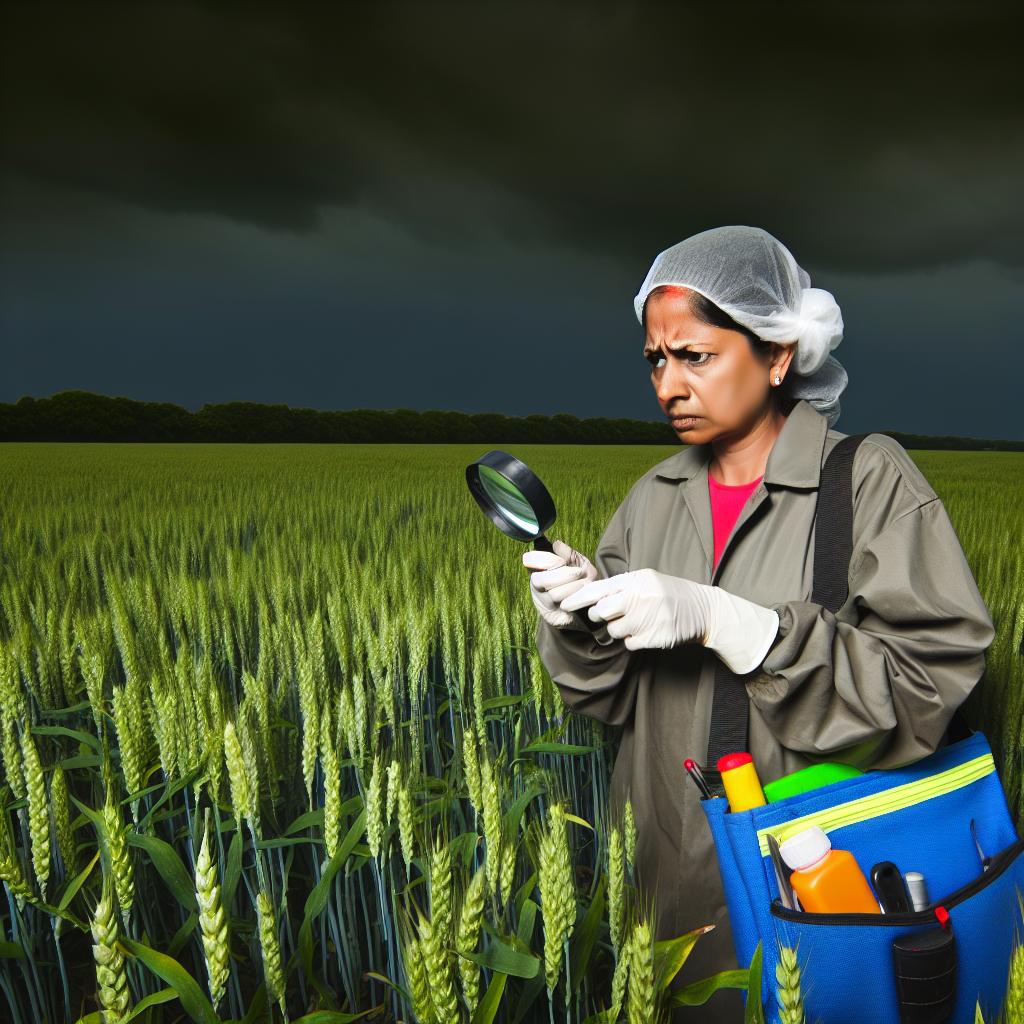Integration of Precision Agriculture Techniques in Crop Protection
Understanding Precision Agriculture
Precision agriculture enhances farming practices through technology.
It utilizes data analysis for better crop management.
This approach minimizes waste and maximizes efficiency.
Benefits of Precision Agriculture in Crop Protection
Precision agriculture offers multiple advantages for crop protection.
- It enables targeted pesticide application.
- Farmers can monitor pest populations accurately.
- Data allows farmers to use resources more effectively.
Technological Tools in Precision Agriculture
Several technological tools aid precision agriculture.
Drones provide aerial imagery for pest detection.
Soil sensors measure moisture and nutrient levels.
Data analytics software helps interpret agricultural data.
Implementing Precision Agriculture Techniques
Farmers should start with baseline data collection.
This data forms the foundation for precision practices.
Regular monitoring is crucial for adjusting strategies.
Collaboration with agronomists can enhance implementation.
Future Trends in Precision Agriculture
The future of precision agriculture looks promising.
Advancements in AI will improve data analysis capabilities.
Moreover, integration with IoT devices will streamline operations.
Transform Your Agribusiness
Unlock your farm's potential with expert advice tailored to your needs. Get actionable steps that drive real results.
Get StartedAs technology evolves, farmers will gain more insights.
Exploring Biopesticides as Sustainable Alternatives to Chemical Solutions
Introduction to Biopesticides
Biopesticides utilize natural materials to control pests.
They are derived from plants, bacteria, and minerals.
Farmers increasingly adopt them due to environmental concerns.
Benefits of Biopesticides
Biopesticides offer numerous advantages over traditional pesticides.
First, they minimize the risk of chemical residues in food.
Second, they promote a healthier ecosystem.
Third, they target specific pests without harming beneficial organisms.
Finally, their effectiveness can lead to improved crop yields.
Types of Biopesticides
There are three primary categories of biopesticides.
- Microbial pesticides contain living microorganisms.
- Plant-incorporated protectants (PIPs) are derived from plants.
- Biochemical pesticides are naturally occurring substances.
Application Methods
Farmers can apply biopesticides in several ways.
Foliar application targets pest populations directly.
Soil application enhances pest resistance from the roots.
Additionally, some biopesticides can be applied through irrigation systems.
Regulatory Framework
The use of biopesticides is governed by various regulations.
In the U.S., the Environmental Protection Agency (EPA) oversees approvals.
Compliance ensures these products meet safety standards.
Similar regulations exist in other countries, promoting global safety.
Challenges and Considerations
Despite their advantages, biopesticides face challenges.
Limited awareness can hinder farmers from using them.
Additionally, biopesticides may require specific application techniques.
Finally, they often work best in combination with other pest control methods.
Looking Ahead
Research continues into new biopesticide development.
Innovations aim to enhance their effectiveness and longevity.
Showcase Your Farming Business
Publish your professional farming services profile on our blog for a one-time fee of $200 and reach a dedicated audience of farmers and agribusiness owners.
Publish Your ProfileAs technology advances, sustainable agriculture will benefit significantly.
Ultimately, biopesticides could play a major role in global food security.
Implementing Integrated Pest Management (IPM) Strategies for Enhanced Crop Resilience
Understanding Integrated Pest Management
Integrated Pest Management is a holistic approach to crop protection.
It combines multiple strategies to control pests effectively.
This reduces reliance on chemical pesticides, promoting sustainability.
Key Components of IPM
IPM incorporates knowledge of pest biology and ecology.
Farmers can prevent pest damage by understanding pest lifecycles.
Regular monitoring helps in identifying pest populations accurately.
Moreover, cultural practices can enhance crop resilience against pests.
Strategies Within IPM
Biological control employs natural enemies to manage pest populations.
For instance, ladybugs control aphid populations efficiently.
Chemical controls, when necessary, are used in a targeted manner.
Additionally, mechanical controls involve physical barriers and traps.
These strategies collectively ensure sustainable pest management.
Implementing IPM Programs
Farmers should develop tailored IPM plans for their crops.
Collaboration with agronomists and local extension services is crucial.
Training programs increase awareness and skill among farmers.
Adopting technology like pest monitoring apps can enhance strategy effectiveness.
Measuring Success in IPM
Regular evaluations of pest management practices are vital.
Monitoring crop yield and pest populations provides necessary insights.
Data collected can help refine future IPM strategies.
Successful implementation leads to higher crop resilience and better yields.
Find Out More: Maximizing Profits Through Efficient Farm Financial Management Practices
Utilizing Genetic Engineering and CRISPR Technology in Disease Resistance
Understanding Genetic Engineering
Genetic engineering modifies organisms’ DNA to enhance desirable traits.
This technique allows scientists to develop plants resistant to specific diseases.
By altering genetic material, researchers can improve crop yields significantly.
Furthermore, genetic engineering can reduce the need for chemical pesticides.
CRISPR Technology Explained
CRISPR is a groundbreaking tool for editing genes with precision.
This technique allows for targeted changes in the DNA sequence of organisms.
It offers high efficiency and flexibility compared to traditional methods.
Moreover, CRISPR facilitates rapid advancements in plant breeding.
Applications in Disease Resistance
Genetic engineering and CRISPR are transforming crop protection strategies.
Farmers now have access to crops that can withstand disease outbreaks.
Additionally, these technologies can enhance crop resilience to environmental stressors.
Noteworthy Examples
Scientists have created blight-resistant potatoes using genetic engineering.
In another instance, CRISPR has been used to develop wheat resistant to rust diseases.
Both innovations demonstrate the potential for reducing losses in yield.
Benefits of Innovative Crop Protection
The utilization of genetic engineering and CRISPR technology offers numerous benefits.
- Increased agricultural productivity is a primary advantage.
- Reduced reliance on harmful chemicals is another significant benefit.
- Enhanced resilience against climate variability improves food security.
Future Directions in Research
Research continues to explore new applications of CRISPR in agriculture.
Scientists aim to broaden the spectrum of disease resistance in crops.
Showcase Your Farming Business
Publish your professional farming services profile on our blog for a one-time fee of $200 and reach a dedicated audience of farmers and agribusiness owners.
Publish Your ProfileCollaboration among researchers, industry, and farmers will drive innovation.
In time, these efforts may lead to sustainable agricultural practices worldwide.
Learn More: Integrating Precision Agriculture for Sustainable Farm Management
Adopting Smart Farming Solutions
Utilizing IoT for Precision Agriculture
The Internet of Things (IoT) revolutionizes modern agriculture.
Farmers can connect devices to gather real-time data.
This technology enhances decision-making processes.
They can track environmental factors and crop conditions.
Consequently, farmers can respond quickly to potential threats.
For instance, soil sensors monitor moisture levels accurately.
These sensors enable irrigation systems to function efficiently.
Data Analytics in Monitoring Crop Health
Data analytics plays a crucial role in crop protection.
By analyzing historical data, farmers can identify patterns.
This information helps predict pest outbreaks and diseases.
Utilizing satellite imagery enhances monitoring across large areas.
Farmers can observe crop growth and identify potential issues early.
Moreover, data analysis supports targeted interventions.
Such actions minimize the need for chemical interventions.
Integrating Machine Learning for Enhanced Predictions
Machine learning algorithms improve crop management strategies.
These systems process vast amounts of data quickly.
They can suggest optimal planting times based on weather patterns.
Additionally, they identify possible infestations before they escalate.
Farmers gain insights tailored to their specific fields.
This personalized approach promotes efficient resource use.
Collaboration with Agritech Startups
Collaboration with agritech startups drives innovation forward.
These partnerships introduce cutting-edge technologies.
Startups often bring fresh perspectives and solutions.
They enable farmers to adopt smart farming practices easily.
Furthermore, this collaboration fosters knowledge sharing.
Farmers learn to leverage technology effectively.
Future Trends in Smart Farming
The future of smart farming looks promising and transformative.
As technologies evolve, new tools will emerge.
These advancements will enhance sustainability in agriculture.
Farmers will increasingly rely on data-driven decisions.
The integration of robotics in farming will grow.
This shift will automate many labor-intensive tasks.
Ultimately, smart farming solutions will secure food production.
You Might Also Like: Renewable Energy Solutions for Diversified Farms

The Role of Community-Based Approaches in Localized Crop Protection
Understanding Community Engagement
Community engagement is vital for effective crop protection strategies.
It fosters a sense of ownership among local farmers.
Moreover, engaged communities share knowledge and resources.
Showcase Your Farming Business
Publish your professional farming services profile on our blog for a one-time fee of $200 and reach a dedicated audience of farmers and agribusiness owners.
Publish Your ProfileBuilding Local Networks
Creating local networks encourages collaborative problem-solving.
Farmers can exchange information about pest management techniques.
Additionally, collaboration facilitates access to shared resources.
Participatory Research Initiatives
Participatory research involves farmers in the innovation process.
This approach empowers them to identify local challenges.
Consequently, solutions become more tailored and effective.
Enhancing Knowledge Sharing
Knowledge sharing strengthens community resilience against pests.
Workshops and training sessions enhance farmer skills.
Farmers learn about sustainable practices and emerging pests.
Utilizing Technology for Collaboration
Technology can enhance community collaboration in crop protection.
Online platforms help farmers report pest outbreaks quickly.
Furthermore, mobile apps facilitate real-time information exchange.
Evaluating the Impact
Regular evaluations measure the effectiveness of community strategies.
These assessments provide insights for continuous improvement.
Ultimately, strong community engagement leads to better crop protection outcomes.
Learn More: Eco-Friendly Pest Management Strategies for Sustainable Farms
Evaluating the Impact of Climate Change on Crop Protection Strategies
Understanding Climate Change Effects
Climate change directly impacts agricultural yields and crop protection methods.
This phenomenon alters weather patterns, making conditions unpredictable.
As a result, farmers face increased pest pressures and disease outbreaks.
Consequently, effective crop protection strategies must adapt to these changes.
Shifts in Pest Populations
Increasing temperatures can lead to rapid pest population growth.
For instance, warmer winters may allow pests to survive longer periods.
This creates a need for timely interventions and preventive measures.
Farmers must monitor pest populations closely to manage outbreaks.
Emergence of New Diseases
Climate change facilitates the spread of new crop diseases.
Higher humidity and temperature levels create favorable conditions for pathogens.
For instance, fungal diseases may become more prevalent in crops.
Consequently, growers must enhance disease surveillance and resistance strategies.
Adapting Crop Varieties
Adapting crop varieties is crucial for maintaining productivity.
Farmers should select resilient strains that withstand climate stresses.
Breeding programs must focus on developing climate-smart varieties.
These varieties should exhibit resistance to both pests and diseases.
Innovative Pest Management Techniques
Integrated Pest Management (IPM) practices can enhance crop protection.
IPM combines biological, cultural, and chemical methods to control pests.
Moreover, precision agriculture technologies offer real-time data for decision-making.
This helps farmers implement targeted interventions when necessary.
Policy and Education Efforts
Government policies must support farmers in adapting to climate realities.
Education and outreach programs can raise awareness of new strategies.
Moreover, funding for research in crop protection is essential.
Collaborative efforts can lead to innovative solutions for climate adaptation.
Showcase Your Farming Business
Publish your professional farming services profile on our blog for a one-time fee of $200 and reach a dedicated audience of farmers and agribusiness owners.
Publish Your ProfileCreating Awareness: Educating Farmers on Modern Crop Protection Techniques
Importance of Education
Education plays a crucial role in crop protection.
Farmers equipped with knowledge make informed decisions.
Furthermore, understanding risks enhances their resilience.
Utilizing Workshops and Training Sessions
Organizing workshops can effectively disseminate information.
Hands-on training boosts farmer confidence in new techniques.
Additionally, inviting experts promotes credible learning.
Leveraging Technology in Education
Digital platforms can enhance educational outreach.
Online courses allow flexible learning opportunities.
Moreover, mobile apps provide timely updates on pest control.
Promoting Community Engagement
Encouraging farmer cooperatives fosters collaboration.
Sharing experiences leads to collective problem-solving.
Communities often identify local pest issues effectively.
Implementing Innovative Teaching Methods
Using multimedia tools can capture attention effectively.
Video demonstrations can clarify complex techniques.
Interactive sessions also encourage active participation.
Continuing Education and Lifelong Learning
Ongoing education ensures farmers stay updated.
Encouraging participation in agricultural conferences is vital.
Networking opportunities enhance knowledge exchange among peers.




